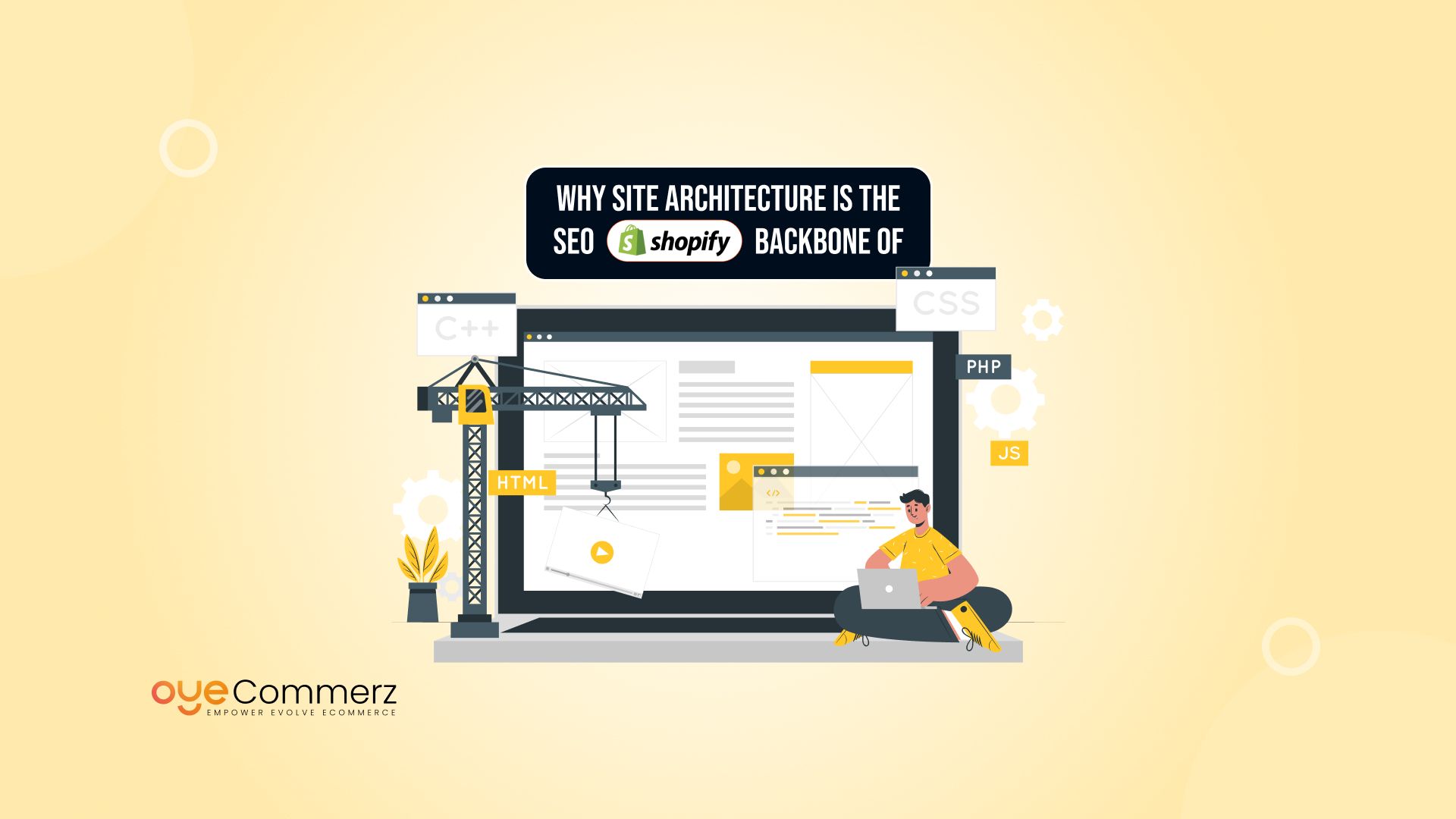Did you know that over 70% of e-commerce sites fail to achieve optimal search rankings due to poor site structure? It’s a silent killer in the world of online retail especially on platforms like Shopify, where store design often takes priority over SEO fundamentals.
That’s a costly mistake.
If your Shopify store isn’t built on a solid architectural foundation, Google can’t properly crawl your site, your content won’t rank, and your users will likely bounce before converting.
This is where Shopify SEO truly begins not with keywords or content, but with how your store is structured from the ground up.
In this blog, we’ll break down everything you need to know about the impact of site architecture on Shopify SEO from basic concepts for e-commerce newcomers to technical strategies for growing brands. You’ll also discover what makes a well-structured Shopify store rank better, convert faster, and scale easier and how to get there.
Whether you’re launching a new Shopify site or optimizing an existing one, understanding and improving your site architecture is the first real step toward long-term SEO success.
Table of Contents
ToggleWhat Is Site Architecture in E-commerce? A Shopify SEO Essential
Site architecture refers to how the pages on your website are organized, structured, and linked together and in the world of Shopify SEO, it’s one of the most important foundations of success.
At its core, a well-designed site architecture ensures that:
- Visitors can easily find what they’re looking for
- Search engines can efficiently crawl and index your site
- Page authority flows naturally throughout your store
In a Shopify store, site architecture typically includes:
- Homepage
- Collections (Categories)
- Product Pages
- Informational Pages (About, Contact, Blog)
A clear and logical structure helps both users and Google understand the hierarchy of your content. When done right, it improves not just SEO performance but also conversion rates and overall site usability.
Why It Matters for Shopify SEO
For Shopify merchants, site architecture isn’t just a design decision it directly affects:
- Keyword visibility
- How fast your pages are indexed
- How internal links distribute ranking power across your store
Poor architecture creates dead ends, confusing paths, and missed opportunities for search rankings. On the other hand, a streamlined structure supports Shopify SEO by making your store accessible, understandable, and crawl-friendly.
Why Site Architecture Matters for Shopify SEO
When it comes to ranking your Shopify store on search engines, site architecture isn’t optional it’s foundational. It determines how search engines like Google discover, crawl, and understand your pages. A poorly structured store can hide your best content, while a well-organized one amplifies it.
Search Engines Rely on Structure
Google’s crawlers follow links to navigate your site. If your architecture is disorganized or too deep (i.e., it takes more than 3 clicks to reach a product), critical pages may be ignored, indexed slowly, or ranked poorly.
A solid site architecture helps search engines:
- Crawl your pages efficiently
- Understand the relationship between different sections
- Prioritize which pages to rank for which keywords
The Role of Internal Linking in Shopify SEO
Site architecture controls how internal links flow across your store. These links pass SEO authority (also known as “link juice”) from one page to another, helping Google identify what’s most important.
When your top-selling product pages or collection pages are buried too deep or not linked strategically, you’re missing out on valuable ranking potential.
How Structure Affects User Experience and Rankings
Google’s algorithm is user-focused. If your site is confusing or difficult to navigate, visitors will bounce quickly and higher bounce rates can negatively affect your rankings.
A clean, intuitive architecture improves:
- Page load speed
- Mobile usability
- Time on site
- Conversion rates
All of these factors are increasingly important signals in Shopify SEO.
Key Principles of an SEO-Friendly Shopify Architecture
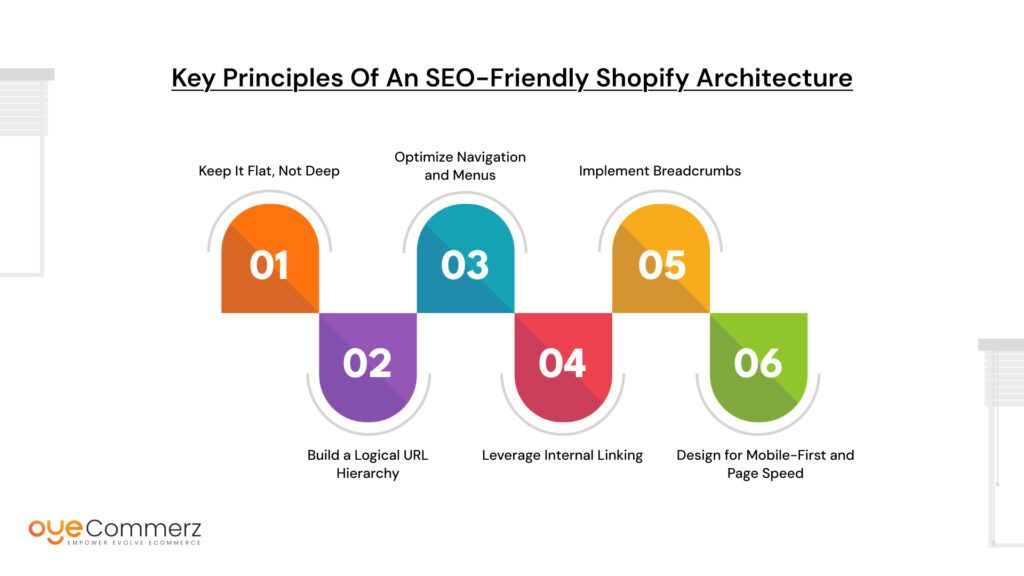
If you want your Shopify store to rank well and convert visitors into customers, the structure of your site needs to support both users and search engines. Here are the core principles of a high-performing Shopify SEO architecture:
1. Keep It Flat, Not Deep
A flat site architecture means users (and search engines) can reach any page within 2 to 3 clicks from the homepage. This ensures faster crawling, better indexing, and easier navigation.
Avoid creating deep structures where products are buried under multiple layers like:
Home > Collections > Sub-Collection > Product Category > Product
Instead, aim for:
Home > Collections > Product
2. Build a Logical URL Hierarchy
Your URL structure should mirror your navigation and help search engines understand page relationships.
Example of SEO-friendly Shopify URLs:
- /collections/shoes
- /collections/shoes/products/running-sneakers
Avoid using random characters or parameters like:
- /product?id=123456
3. Optimize Navigation and Menus
Your main navigation should highlight top-level categories and important pages. Use descriptive, keyword-rich labels for menus to guide both users and search engines.
Also include:
- A clear footer menu with SEO pages (About, Contact, Shipping)
- Search functionality for large inventories
4. Leverage Internal Linking
Internal links are crucial for Shopify SEO. Link related products, collections, and blog posts to:
- Pass authority between pages
- Help Google understand content relevance
- Guide users through their buying journey
5. Implement Breadcrumbs
Breadcrumbs improve both navigation and crawlability. They help users backtrack easily and show search engines how pages fit into your site hierarchy.
Example:
Home > Collections > Running Shoes > Nike ZoomX
6. Design for Mobile-First and Page Speed
Shopify themes are mobile-optimized, but always test your layout and navigation on different screen sizes. A fast, responsive site architecture improves user experience and Shopify SEO performance.
Use tools like:
- Google PageSpeed Insights
- Shopify Analyzer
- Lighthouse
By applying these foundational principles, your Shopify site will be easier to navigate, faster to load, and better equipped to climb the search engine rankings. In the next section, we’ll take it a step further with a technical deep-dive into Shopify SEO architecture for growing and scaling brands.
Technical Deep-Dive: Structuring Your Shopify Store for SEO Success
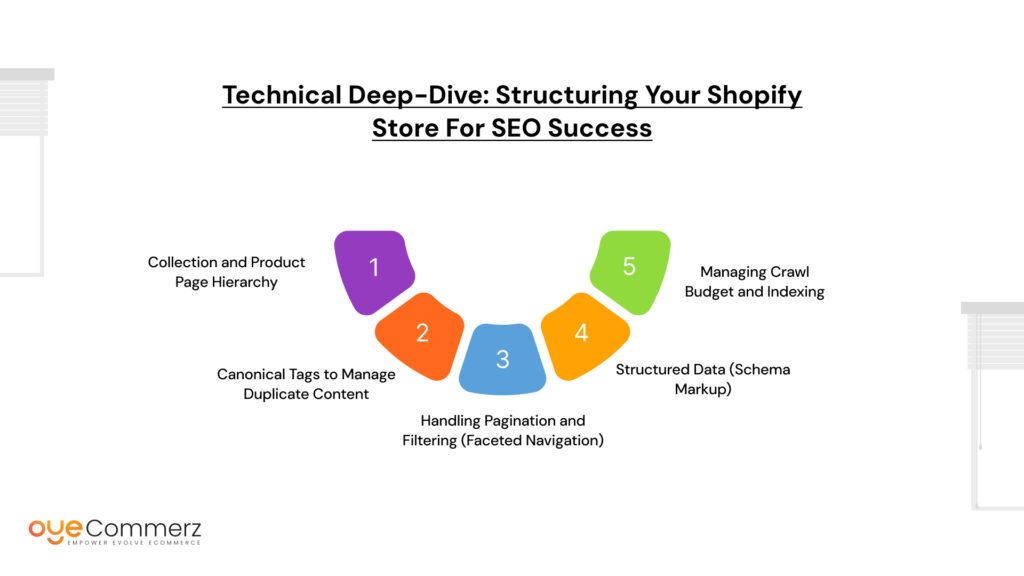
Once you’ve covered the foundational elements of site architecture, it’s time to explore the technical factors that directly influence Shopify SEO performance. These behind-the-scenes elements can either help your store scale organically or hold it back from ranking altogether.
1. Collection and Product Page Hierarchy
In Shopify, collections act as category pages, and product pages are nested under them. Ensure each product:
- Belongs to the most relevant collection
- Uses consistent naming conventions
- Has a unique, keyword-optimized URL
Avoid duplicate listings under multiple collections unless necessary, and use canonical tags when needed.
2. Canonical Tags to Manage Duplicate Content
Shopify can generate duplicate content due to product variations, tags, and sorting parameters. Canonical tags help tell Google which version of a page is the original or preferred one to index.
Make sure:
- Each product page has a self-referencing canonical tag
- Collection filters don’t create duplicate URL paths
3. Handling Pagination and Filtering (Faceted Navigation)
Shopify doesn’t natively support advanced filtering with SEO best practices. If you use filters like color, size, or price:
- Avoid creating indexable URLs for each filter combination
- Use “nofollow” or “noindex” tags where necessary
- Consolidate link equity to core pages
Custom development or Shopify apps may be needed to manage this at scale.
4. Structured Data (Schema Markup)
Adding schema markup to your Shopify store helps search engines understand your content better. It also increases your chances of earning rich snippets in search results, such as:
- Product ratings
- Price and availability
- Breadcrumbs
Use Shopify SEO apps or custom code to implement JSON-LD schema for:
- Products
- Articles
- Breadcrumbs
5. Managing Crawl Budget and Indexing
Crawl budget refers to how often Google crawls your site. For larger stores, optimizing your architecture helps ensure that important pages are crawled and indexed efficiently.
Best practices:
- Submit an updated XML sitemap via Google Search Console
- Block irrelevant pages in your robots.txt file (like search result pages)
- Reduce crawl depth across your site
These technical optimizations are vital for scaling your store and maintaining long-term Shopify SEO performance. In the next section, we’ll shift gears and break down the essentials for e-commerce beginners, so you can build your foundation the right way from day one.
For E-commerce Beginners: A Simple Guide to Shopify SEO and Site Structure
If you’re new to e-commerce, terms like site architecture and Shopify SEO can feel overwhelming but they don’t have to be. Getting the basics right from the start will save you time, money, and lost traffic down the road.
Here’s what you need to know.
What Is Shopify SEO in Simple Terms?
Shopify SEO is the process of optimizing your Shopify store so that it appears higher in Google search results when customers look for products you sell. It includes using the right keywords, optimizing product pages, and critically structuring your site in a way that search engines and users can easily understand.
Why Site Architecture Matters, Even for Small Stores
Think of your site structure as the floor plan of a store. If products are scattered all over the place with no clear sections, shoppers will get confused and leave. Search engines behave the same way.
Even if your store has just a few products, you should:
- Organize them into logical collections
- Keep navigation simple and clear
- Use clean, keyword-based URLs
Common Mistakes Beginners Make
- Creating too many categories or menus
- Using generic product titles like “Item 1” or “New Product”
- Ignoring page speed and mobile layout
- Overlooking internal links between products or blog content
3 Easy Shopify SEO Tips for Beginners
- Stick to 2–3 Clicks: Make sure every product can be reached within 2–3 clicks from the homepage.
- Use Descriptive Titles and URLs: For example, use /collections/organic-teas instead of /product?id=123.
- Start Blogging Early: Blogging helps you rank for more keywords and improves internal linking.
Starting with a clear site architecture is one of the smartest moves you can make as a new store owner. It sets the stage for long-term Shopify SEO success and a better shopping experience for your customers.
Good vs. Poor Site Architecture: A Shopify SEO Comparison
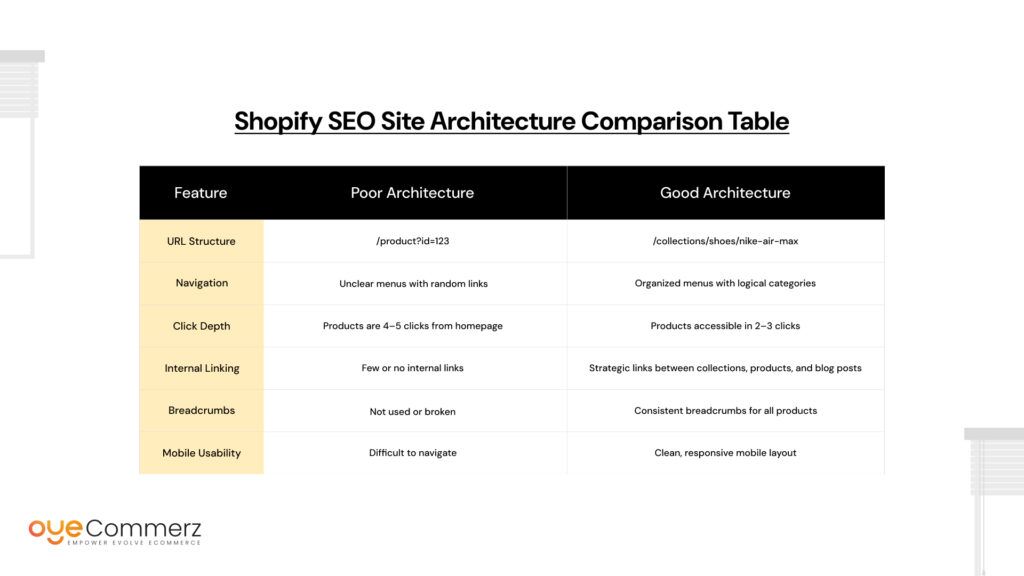
Understanding what separates a well-structured store from a poorly structured one is essential to improving your Shopify SEO. Below is a side-by-side comparison to help you quickly identify gaps in your current setup and recognize best practices.
Why This Matters for Shopify SEO
Google and users both prefer sites that are easy to navigate and logically structured. A poor site architecture:
- Confuses search engines
- Slows down indexing
- Weakens keyword targeting
- Increases bounce rates
A strong architecture supports Shopify SEO by improving crawlability, distributing link authority efficiently, and creating a seamless experience for shoppers across all devices.
Best Practices & Tools for Auditing Shopify Site Structure
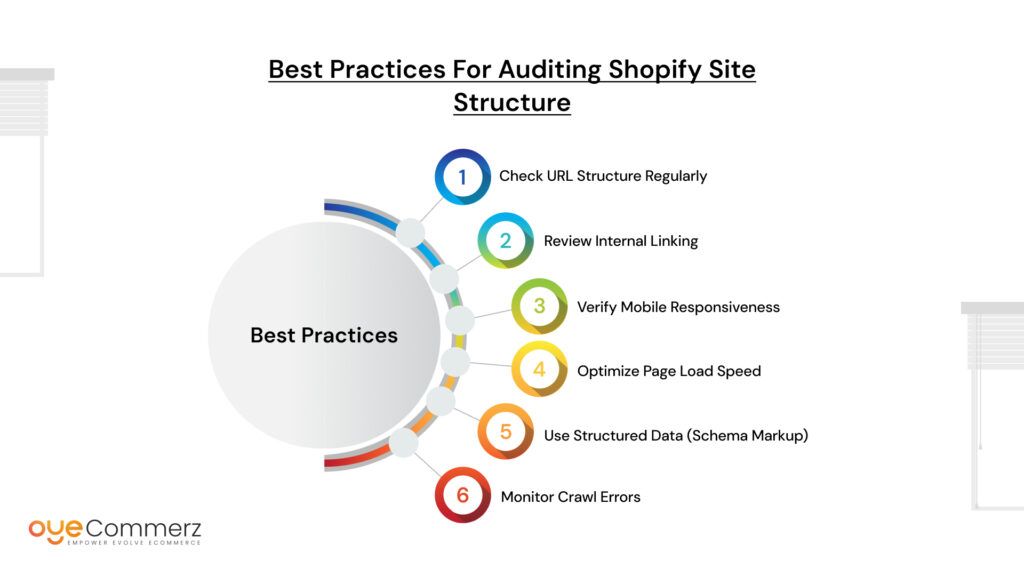
Optimizing and maintaining a strong Shopify site structure isn’t a one-time task it’s an ongoing process. Regular audits are essential to ensure your site stays crawlable, user-friendly, and optimized for SEO. Here’s how you can audit and fine-tune your Shopify SEO site structure, along with some powerful tools and apps to help you stay on top of things.
Best Practices for Auditing Shopify Site Structure
- Check URL Structure Regularly
- Ensure all URLs are descriptive, short, and include relevant keywords.
- Avoid using dynamic parameters or session IDs in URLs.
- Use canonical tags to avoid duplicate content issues.
- Ensure all URLs are descriptive, short, and include relevant keywords.
- Review Internal Linking
- Check that all important pages are well-linked throughout the site.
- Ensure there are no broken internal links, which could hinder crawlability and user experience.
- Use internal linking to distribute link equity to high-priority pages.
- Check that all important pages are well-linked throughout the site.
- Verify Mobile Responsiveness
- Test your site on various devices to ensure it’s responsive and easy to navigate on mobile.
- Ensure navigation menus and buttons are functional on smaller screens.
- Test your site on various devices to ensure it’s responsive and easy to navigate on mobile.
- Optimize Page Load Speed
- A slow site can hurt your rankings. Regularly test load times using tools like Google PageSpeed Insights.
- Compress large images and scripts, and use lazy loading where possible.
- A slow site can hurt your rankings. Regularly test load times using tools like Google PageSpeed Insights.
- Use Structured Data (Schema Markup)
- Ensure all products, reviews, and breadcrumbs use proper structured data markup.
- Regularly check for missing or incorrect schema using tools like Google’s Rich Results Test.
- Ensure all products, reviews, and breadcrumbs use proper structured data markup.
- Monitor Crawl Errors
- Regularly check Google Search Console for crawl errors or blocked pages.
- Address 404 errors, broken redirects, and server errors promptly.
- Regularly check Google Search Console for crawl errors or blocked pages.
Tools for Auditing Shopify Site Structure
- Google Search Console
- Use: Monitor your site’s performance in Google search results, fix crawl errors, and see which pages are indexed.
- What to check: Crawl errors, page indexing issues, mobile usability, performance data.
- Use: Monitor your site’s performance in Google search results, fix crawl errors, and see which pages are indexed.
- Screaming Frog
- Use: A powerful site crawler that audits your entire website for SEO issues.
- What to check: Page titles, meta descriptions, heading tags, broken links, and duplicate content.
- Use: A powerful site crawler that audits your entire website for SEO issues.
- Ahrefs
- Use: Conduct detailed link audits, analyze backlinks, and track keyword rankings.
- What to check: Backlink profile, internal linking structure, and competitive site analysis.
- Use: Conduct detailed link audits, analyze backlinks, and track keyword rankings.
- SEMrush
- Use: Comprehensive site audit tool for checking site health, including broken links, missing meta tags, and other technical SEO issues.
- What to check: Site audit, on-page SEO issues, backlink analysis, and keyword tracking.
- Use: Comprehensive site audit tool for checking site health, including broken links, missing meta tags, and other technical SEO issues.
Checklist for Ongoing Shopify SEO Optimization
- Regularly Check Site Health
- Run a full site audit at least once a month using tools like Screaming Frog or SEMrush to ensure no major SEO issues have arisen.
- Run a full site audit at least once a month using tools like Screaming Frog or SEMrush to ensure no major SEO issues have arisen.
- Monitor Internal Linking and URL Structure
- Ensure that new pages are being added to the internal link structure, especially if you’re adding products or collections.
- Ensure that new pages are being added to the internal link structure, especially if you’re adding products or collections.
- Review Google Search Console
- Monitor performance metrics and check for crawl errors, manual actions, and indexing issues.
- Monitor performance metrics and check for crawl errors, manual actions, and indexing issues.
- Check Page Load Speed
- Use tools like Google PageSpeed Insights and GTMetrix to ensure the site is loading fast and efficiently.
- Use tools like Google PageSpeed Insights and GTMetrix to ensure the site is loading fast and efficiently.
- Keep Content Fresh
- Regularly update product pages, blog posts, and other content to keep it relevant and engaging for both users and search engines.
- Regularly update product pages, blog posts, and other content to keep it relevant and engaging for both users and search engines.
- Track Keyword Performance
- Use Ahrefs, SEMrush, or Google Analytics to track keyword rankings, analyze trends, and optimize pages for better SEO performance.
By leveraging these Shopify SEO tools and regularly auditing your site structure, you ensure that your store remains optimized for both search engines and customers. The continuous effort you put into improving site architecture will pay off in the form of better rankings, more organic traffic, and an improved user experience.
Migrating to Shopify? Let Oyecommerz Set You Up for SEO Success
Thinking of moving your store to Shopify? Whether you’re coming from Magento, WooCommerce, Squarespace, or another platform, your Shopify SEO journey begins the moment you start planning your site migration.
The biggest mistake brands make during migration? Ignoring SEO and site architecture.
If not done properly, migration can result in:
- Broken URLs and lost traffic
- Duplicate content issues
- Dropped rankings
- Missed opportunities to optimize structure
Why Choose Oyecommerz for Your Shopify Migration?
At Oyecommerz, we specialize in Shopify migration services that go beyond just moving products and themes. We ensure your site architecture is clean, crawlable, and fully optimized for SEO from day one.
Here’s how we help:
- Map and redirect old URLs to preserve rankings
- Set up optimized collections and product hierarchies
- Implement SEO-friendly URL structures
- Configure canonical tags, internal links, and schema markup
- Ensure fast page speeds and mobile optimization
Whether you’re a small business or scaling enterprise, our team ensures a seamless, search-engine-friendly transition to Shopify without sacrificing your visibility or rankings.
Ready to launch a store that’s built for growth?
Explore our Shopify Migration Services and get started today.
Contact to Migrate your Site to Shopify Now
Conclusion
Site architecture is more than just navigation it’s the framework that powers your Shopify SEO strategy. A well-structured store helps search engines crawl efficiently, keeps users engaged, and builds a solid foundation for long-term growth.
Let’s recap the key points:
- A flat, logical structure boosts visibility and usability
- Proper internal linking and navigation improve rankings
- Technical SEO elements like canonical tags and schema are essential for scaling
- Even beginners can benefit from clean, simple site design
- Migration is the best time to get architecture and SEO right don’t overlook it
Whether you’re launching a new store or improving an existing one, site architecture should be your starting point. It’s not just about how your store looks it’s about how it performs in search and how easily customers can shop.
Frequently Asked Questions
Website architecture impacts SEO by determining how easily search engines can crawl and index your site. A well-structured site with clear navigation, logical URL hierarchy, and proper internal linking ensures better indexing, higher rankings, and improved user experience.
Yes, Shopify websites are generally SEO-friendly. Shopify offers built-in SEO features like customizable title tags, meta descriptions, clean URL structures, and mobile optimization. However, success also depends on how the site is structured, how content is optimized, and the ongoing SEO efforts.
To optimize SEO on Shopify:
- Use descriptive, keyword-rich URLs
- Optimize page titles and meta descriptions
- Ensure proper internal linking
- Add alt text for images
Regularly monitor site performance with tools like Google Search Console and Ahrefs
Mobile optimization is crucial for Shopify SEO as Google uses mobile-first indexing. A mobile-friendly design ensures better rankings, faster page load times, and a better user experience, which can significantly impact conversion rates and site performance.
Site speed is a critical factor for Shopify SEO. Faster websites have better user retention, higher rankings, and improved mobile performance. Slow-loading pages lead to higher bounce rates and can negatively impact your site’s search engine performance.

